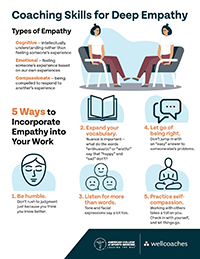Wellcoaches |
Oct.
18, 2023

Psychologist Carl Rogers believed that every person is naturally inclined to grow in a positive direction, not only for themselves but for society and their community. Rogers therefore suggested that it’s unhelpful and unnecessary to center a coaching or therapeutic relationship on telling, directing, and prescribing. When such relationships are grounded instead in authenticity, warmth, and empathetic understanding, patients are more likely to grow — and to stick with that growth.
Authenticity — showing up as ourselves with the best of our personalities — may actually come quite easily to us, particularly as we enter into the later stages of our careers set on a firm foundation of competence and experience. And warmth is likely a strength of yours as well. After all, you entered this field because of your care for others and passion for their well-being.
But what if we’re not naturally empathetic? Is it possible to learn how to be empathetic?
First, let’s examine the different types of empathy. Helen Reiss, associate professor of psychiatry at Harvard Medical School, describes three types: cognitive, emotional, and compassionate.
-
Cognitive empathy enables one to make a guess about how another person feels and what they might be thinking. This type of empathy allows us to acknowledge that the other person has thoughts and feelings separate from our own. This is a learned skill.
-
Emotional empathy refers to when one feels what another feels. We imagine the inner experience of the other person based on our own past experience. While examining our own experiences can help point us to what the other person might be feeling, it can also be a dangerous temptation to see the situation through our own eyes rather than theirs.
-
Compassionate empathy is what moves us to respond to another person’s feelings and care about their welfare, offering a compassionate response. However, this can also lead to distress when we take on the responsibility of another person’s choices, leading to burnout.
The healthiest approach for you and your patient is one that allows you to explore how the other person is feeling and acknowledge it — and to care about their situation without the “righting” or “fixing” reflex that can undermine their autonomy and make us feel emotionally bound up in their situation.
By the way, this isn’t just about getting through empathy and on to the “real work” of goal-setting and action-planning. Empathy in health care providers actually leads to better clinical outcomes, better understanding of symptoms and more effective treatment plans.
Five Steps to Feelings
Here are five practical ways to bring empathy into your work.
-
Be humble. Humility allows us to fairly consider others’ experiences, perspectives, beliefs and desires even if they don’t align with our own. For the health care practitioner with a passion for well-being, it can be challenging to see through the lens of those who are overweight, don’t exercise, etc. Humility encourages us to recognize our own shortcomings and extend grace to those in circumstances that differ from our own.
-
Expand your vocabulary. Familiarize yourself with a more extensive tool kit of words that describe feelings. You can guess that patients might feel happy, mad, sad, or glad. But refining your language — incorporating words like “delighted,” “scared,” “disconnected,” or “satisfied” will help you and your patient have a clearer understanding of what is happening for them. And that understanding will lead to better behaviors and solutions.
-
Listen for more than words. Our fight-or-flight response lives in the same area of our brain where tone of voice and facial expressions reside. In other words, our patients’ feelings are often right there for us to see if we simply look. Listen for the cues in the shape of their words and watch for the cues written on their face as they deliver them. Never take words alone as the whole story.
-
Let go of being “right.” Check in with your intentions about your relationship with your patient. Do you feel inclined to correct, be in charge, or change their mind? Or do you seek to connect, partner with them, and learn about their perspective?
-
Practice self-compassion. Empathy begins with compassion for yourself. In the spirit of the great song lyric from Travis Meadows, “You push it down, it comes out sideways,” take the necessary steps for self-care before each conversation. With your new vocabulary for feelings, ask yourself, “What am I feeling in this moment and why?” Be intentional about setting aside any feelings that might interfere with your ability to show up fully to your patient, and give yourself permission to revisit them at a set time.
Find more resources from Wellcoaches here

Download the infographic